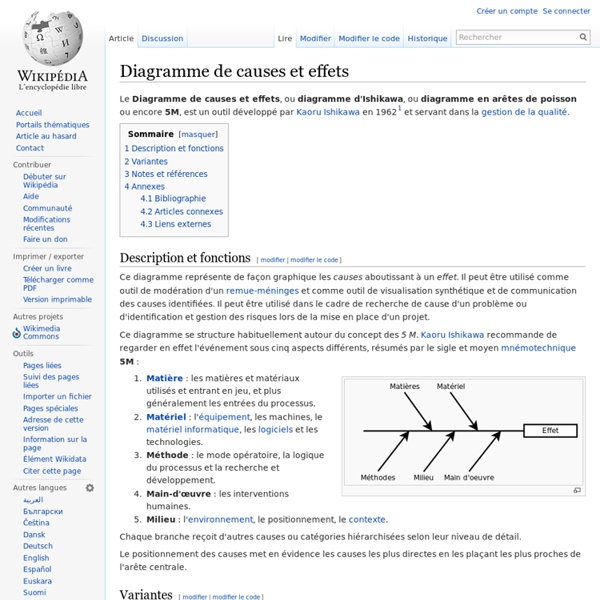Diagramme de causes et effets
http://fr.wikipedia.org/wiki/Diagramme_de_causes_et_effets
Related: OUTILS DE RÉSOLUTION DE PROBLÈMES
Cause Mapping Basics
Root Cause Analysis Root cause analysis is an approach for identifying the underlying causes of why an incident occurred so that the most effective solutions can be identified and implemented. It's typically used when something goes badly, but can also be used when something goes well. Within an organization, problem solving, incident investigation and root cause analysis are all fundamentally connected by three basic questions: What's the problem?
5 Whys - Problem Solving Skills from MindTools
Quickly Getting to the Root of a Problem How to use the 5 Whys technique, with James Manktelow & Amy Carlson. The 5 Whys is a simple problem-solving technique that helps you to get to the root of a problem quickly. Made popular in the 1970s by the Toyota Production System, the 5 Whys strategy involves looking at any problem and asking: "Why?" and "What caused this problem?"
Determine The Root Cause: 5 Whys
Asking “Why?” may be a favorite technique of your three year old child in driving you crazy, but it could teach you a valuable Six Sigma quality lesson. The 5 Whys is a technique used in the Analyze phase of the Six Sigma DMAIC (Define, Measure, Analyze, Improve, Control) methodology. It is a great Six Sigma tool that does not involve data segmentation, hypothesis testing, regression or other advanced statistical tools, and in many cases can be completed without a data collection plan.
5 Whys
The 5 Whys is an iterative question-asking technique used to explore the cause-and-effect relationships underlying a particular problem.[1] The primary goal of the technique is to determine the root cause of a defect or problem. (The "5" in the name derives from an empirical observation on the number of iterations typically required to resolve the problem.) Example[edit]
Related:



